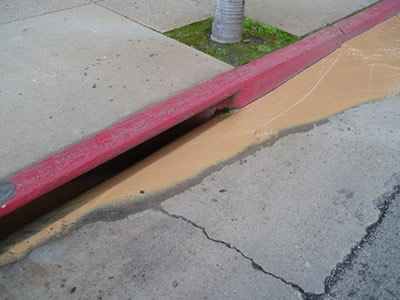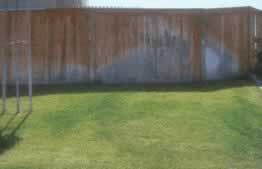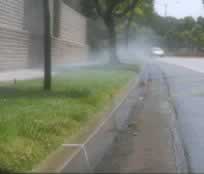- TABLE OF CONTENTS
- GETTING STARTED
- DESIGN
- Introduction to Design
- Questionnaire
- Principles of Design
- Creating the Design
- Drainage
- Plant Design
- Installing the Garden
- Working With Professionals
- IRRIGATION
- Introduction to Irrigation
- Plant Water Needs
- Before You Design
- Smart Controllers
- Types of Irrigation Systems
- Eliminating Run-off and Overspray
- MAINTENANCE
Eliminating Run-off and Overspray
Run-off
Run-off occurs when water is applied too fast, or in too great an amount, to the soil. In addition to over-watering (applying too much water overall), run-off can occur on sloped landscapes when landscapes are watered too long for their soil type.
Most soils absorb water much slower than sprinkler systems apply the water to the landscape. It is best to use multiple, short duration watering times (cycles) with enough time between each cycle to allow the water to soak into the soil.
Sloping and poorly graded land can cause run-off. Terracing and shallow watering basins can help prevent run-off on sloped areas. Broad, shallow basins are generally better than deep, narrow ones; the wider the basin, the wider root area you can soak.
 |
Once your sprinkler system has run through all the cycles, let the landscape rest and have a chance to completely absorb the water for at least a day before repeating the process. Determining the length and frequency of watering for your landscape is a simple process. Go to the Plant section of this site and note the hydrozone designation (level of water use and sun/shade necessary) for each of your particular plants. Now visit the Watering Guide. Match the hydrozone designations to the watering schedules. The Plant Section and Watering Guide can be found on the Main Menu.
Overspray
Overspray is simply the water that lands beyond the planted or target area. When the overspray lands on sidewalks, drives and other hard surfaces it can, and does, empty into the streets and local waterways. Garden beds and irrigation systems should be designed to avoid overspray onto impervious surfaces. Lawns should be held back from streets and driveways. Overhead irrigation should not be used in planting areas directly adjacent to streets, driveways and waterways. Irregular-shapes and narrow strips of lawn should be avoided, as it is difficult to water them without the occurrence of overspray.
 |
Water running off the landscape will carry pesticides and fertilizers used on that landscape. Once in the street, runoff may also pick up oil, trash, sediment and other pollutants. Also drained swimming pool water is chlorinated and can be deadly to aquatic life.
Unlike sewers, storm drains are not connected to treatment plants. Water and pollution that runs off of streets and land flows directly into rivers, creeks, sloughs and the ocean without being filtered or treated. In inland areas, storm drain runoff is sometimes directed into open spaces where it percolates into the ground.
Water pollution is a serious problem because it causes changes in the biological, physical and chemical characteristics of a water body. Some attributes of water that are affected by pollution are pH, acidity, dissolved oxygen content, nutrient or sediment load and the presence or absence of pathogens. Changes in these attributes caused by pollution can harm aquatic life, create unpleasant odors and, in the case of pathogens, may cause disease in humans that come into contact with the water.
The hidden costs of overspray and run-off:
Paying for water that is not needed, or used, in the garden.
Accelerated deterioration of asphalt drives and parking areas.
Damage to fences, siding, patios, walks and other garden structures.
Reducing water quality at creeks and beaches.
Harming aquatic life.
Causing disease in humans that come into contact with polluted waters.
Creek clean up and watershed restoration projects.
 |